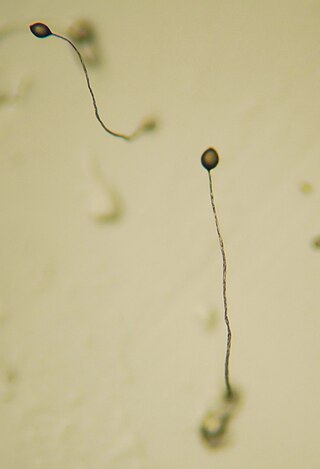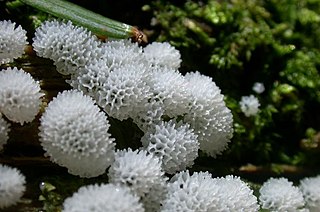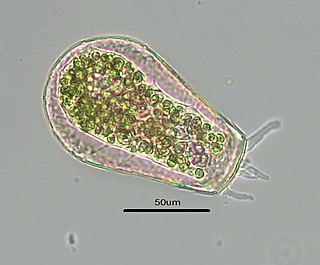
Entamoeba is a genus of Amoebozoa found as internal parasites or commensals of animals. In 1875, Fedor Lösch described the first proven case of amoebic dysentery in St. Petersburg, Russia. He referred to the amoeba he observed microscopically as Amoeba coli; however, it is not clear whether he was using this as a descriptive term or intended it as a formal taxonomic name. The genus Entamoeba was defined by Casagrandi and Barbagallo for the species Entamoeba coli, which is known to be a commensal organism. Lösch's organism was renamed Entamoeba histolytica by Fritz Schaudinn in 1903; he later died, in 1906, from a self-inflicted infection when studying this amoeba. For a time during the first half of the 20th century the entire genus Entamoeba was transferred to Endamoeba, a genus of amoebas infecting invertebrates about which little is known. This move was reversed by the International Commission on Zoological Nomenclature in the late 1950s, and Entamoeba has stayed 'stable' ever since.

The Percolozoa are a group of colourless, non-photosynthetic Excavata, including many that can transform between amoeboid, flagellate, and cyst stages.

Nucleariida is a group of amoebae with filose pseudopods, known mostly from soils and freshwater. They are distinguished from the superficially similar vampyrellids mainly by having mitochondria with discoid cristae, in the absence of superficial granules, and in the way they consume food.

Slime mold or slime mould is an informal name given to a polyphyletic assemblage of unrelated eukaryotic organisms in the Stramenopiles, Rhizaria, Discoba, Amoebozoa and Holomycota clades. Most are microscopic; those in the Myxogastria form larger plasmodial slime molds visible to the naked eye. The slime mold life cycle includes a free-living single-celled stage and the formation of spores. Spores are often produced in macroscopic multicellular or multinucleate fruiting bodies that may be formed through aggregation or fusion; aggregation is driven by chemical signals called acrasins. Slime molds contribute to the decomposition of dead vegetation; some are parasitic.

Acanthamoeba is a genus of amoebae that are commonly recovered from soil, fresh water, and other habitats. The genus Acanthamoeba has two stages in its life cycle, the metabolically active trophozoite stage and a dormant, stress-resistant cyst stage. In nature, Acanthamoeba species are generally free-living bacterivores. However, they are also opportunistic pathogens able to cause serious and sometimes fatal infections in humans and other animals.

The Rhizaria are a diverse and species-rich supergroup of mostly unicellular eukaryotes. Except for the Chlorarachniophytes and three species in the genus Paulinella in the phylum Cercozoa, they are all non-photosynthethic, but many foraminifera and radiolaria have a symbiotic relationship with unicellular algae. A multicellular form, Guttulinopsis vulgaris, a cellular slime mold, has been described. This group was used by Cavalier-Smith in 2002, although the term "Rhizaria" had been long used for clades within the currently recognized taxon. Being described mainly from rDNA sequences, they vary considerably in form, having no clear morphological distinctive characters (synapomorphies), but for the most part they are amoeboids with filose, reticulose, or microtubule-supported pseudopods. In the absence of an apomorphy, the group is ill-defined, and its composition has been very fluid. Some Rhizaria possess mineral exoskeletons, which are in different clades within Rhizaria made out of opal, celestite, or calcite. Certain species can attain sizes of more than a centimeter with some species being able to form cylindrical colonies approximately 1 cm in diameter and greater than 1 m in length. They feed by capturing and engulfing prey with the extensions of their pseudopodia; forms that are symbiotic with unicellular algae contribute significantly to the total primary production of the ocean.
The Vannellidae are a family of Amoebozoa, which are found in soil, fresh- and salt water. The most common genus is Vannella.

Discosea is a class of Amoebozoa, consisting of naked amoebae with a flattened, discoid body shape. Members of the group do not produce tubular or subcylindrical pseudopodia, like amoebae of the class Tubulinea. When a discosean is in motion, a transparent layer called hyaloplasm forms at the leading edge of the cell. In some discoseans, short "subpseudopodia" may be extended from this hyaloplasm, but the granular contents of the cell do not flow into these, as in true pseudopodia. Discosean amoebae lack hard shells, but some, like Cochliopodium and Korotnevella secrete intricate organic scales which may cover the upper (dorsal) surface of the cell. No species have flagella or flagellated stages of life.

Arcellinid testate amoebae or Arcellinida, Arcellacean or lobose testate amoebae are single-celled protists partially enclosed in a simple test (shell).

Dictyostelium discoideum is a species of soil-dwelling amoeba belonging to the phylum Amoebozoa, infraphylum Mycetozoa. Commonly referred to as slime mold, D. discoideum is a eukaryote that transitions from a collection of unicellular amoebae into a multicellular slug and then into a fruiting body within its lifetime. Its unique asexual life cycle consists of four stages: vegetative, aggregation, migration, and culmination. The life cycle of D. discoideum is relatively short, which allows for timely viewing of all stages. The cells involved in the life cycle undergo movement, chemical signaling, and development, which are applicable to human cancer research. The simplicity of its life cycle makes D. discoideum a valuable model organism to study genetic, cellular, and biochemical processes in other organisms.

Protosteliomycetes/Protosteliales (ICBN) or Protostelea/Protostelia/Protosteliida (ICZN) is a grouping of slime molds from the phylum Mycetozoa. The name can vary depending upon the taxon used. Other names include Protostelea, Protostelia, and Protostelida. When not implying a specific level of classification, the term protostelid or protosteloid amoeba is sometimes used.
Hartmannella is a genus of Amoebozoa.

Testate amoebae are a polyphyletic group of unicellular amoeboid protists, which differ from naked amoebae in the presence of a test that partially encloses the cell, with an aperture from which the pseudopodia emerge, that provides the amoeba with shelter from predators and environmental conditions.

Vahlkampfiidae is a family of Heterolobosea.
Willaertia /ˈwɪləɹʃə/ is a genus of non-pathogenic, free-living, thermophilic amoebae in the family Vahlkampfiidae.

The vampyrellids, colloquially known as vampire amoebae, are a group of free-living predatory amoebae classified as part of the lineage Endomyxa. They are distinguished from other groups of amoebae by their irregular cell shape with propensity to fuse and split like plasmodial organisms, and their life cycle with a digestive cyst stage that digests the gathered food. They appear worldwide in marine, brackish, freshwater and soil habitats. They are important predators of an enormous variety of microscopic organisms, from algae to fungi and animals. They are also known as aconchulinid amoebae.
Vahlkampfia inornata is a species of excavates. It has a PAS-positive surface layer and forms cysts in culture.
Vahlkampfia jugosa is a species of excavates. It has a PAS-positive surface layer and forms cysts in culture.

An amoeba, often called an amoeboid, is a type of cell or unicellular organism with the ability to alter its shape, primarily by extending and retracting pseudopods. Amoebae do not form a single taxonomic group; instead, they are found in every major lineage of eukaryotic organisms. Amoeboid cells occur not only among the protozoa, but also in fungi, algae, and animals.

Hyalospheniidae is a family of arcellinid testate amoebae and the sole family of the infraorder Hyalospheniformes. Commonly referred to as "hyalospheniids", these lobose amoebae are characterized by their ability to generate a shell composed of either organic matter or siliceous particles that may be recycled from euglyphid amoebae. They inhabit soil or freshwater habitats, and are abundant on Sphagnum mosses.













